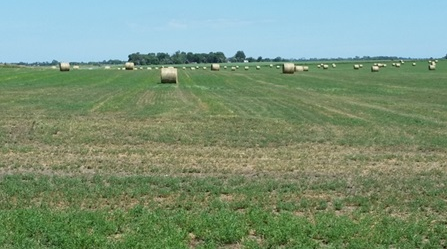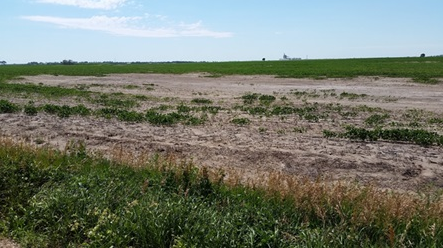By Anthony Bly,
Extension Soils Field Specialist
Salt affected soils have become a significant soil health problem in many regions of South Dakota, especially in the James River Valley. The salts causing this problem are naturally occurring and were deposited in the landscape long ago.
These salts contains calcium, magnesium, sodium, potassium, chloride, and sulfate. The salts are being redistributed in the landscape due to higher than usual precipitation than in the past and cropping systems that don’t use significant soil water during the whole growing season.
Prior to breaking the prairie for crop production, the prairie grass used most of the water provided by precipitation.
However, in the past few decades, excess water has moved through the soil profile and along and over relatively impermeable soil layers high in clay content and picked up the salts which are then deposited when the water reaches a place in the landscape where it evaporates.
These salt affected soils can easily be identified by the white appearance at the soil surface. Crop growth and yield on these areas can be reduced to non-existent depending on the salt concentration in the soil.
Managing Salt-Affected Soil
There are two main management practices that can reduce the salt affected soil problem.

|

|
| Figure 1. Salt-affected soil reclaimed by perennial forage production. | Figure 2. Salt-affected soil across the road from field shown in Figure 1. |
Tile drainage, which lowers the water table, will help remove excess water and provide drainage for the salts to move lower in the profile. However, this management approach really doesn’t solve the root of this problem because excess water is still moving through the soil and picking up salts. The influence of the tile drainage can only be effective to the installation depth.
A more conclusive way to solve this problem is to use the water on the landscape for crop and/or forage production. Alfalfa, grass and cover crop production are good example of farming practices that can use large amounts of water and slow or stop the movement salts towards affected areas.
The alfalfa, grass and cover-crop roots use a large amount of water which lowers the water table and allows the salts to move (leach) deeper in the soil profile as well. A good example of this success is near Redfield, SD.
Figure 1 shows a field with salt tolerant alfalfa and Rosana western wheatgrass that previously appeared very salty as the soil in Figure 2.
As a matter of fact, the two fields in these photos are only separated by a gravel township road. Perennial forage is successful in using more soil water and allowing the salts in the affected soils to move deeper in the profile therefore permitting successful plant growth.






Post a comment
Report Abusive Comment